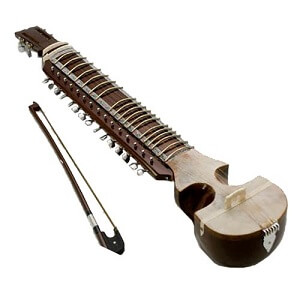Esraj
 Esraj is a stringed instrument made of wood, goat skin and horse hair. This traditional instrument is found in West Bengal. Majorly used in North Indian classical concerts as a solo instrument. Also a popular accompanying instrument of Rabindra Sangeet.
Esraj is a stringed instrument made of wood, goat skin and horse hair. This traditional instrument is found in West Bengal. Majorly used in North Indian classical concerts as a solo instrument. Also a popular accompanying instrument of Rabindra Sangeet.
A medium-sized bowed instrument. Resonator and fingerboard with peg box made separately and later on joined together. Entire body made of wood, resonator covered with goat skin. Four main strings, 15 sympathetic strings and nineteen frets. Played with a horse hair bow. Used in North Indian classical concerts as a solo instrument. Also a popular accompanying instrument of Rabindra Sangeet.
Of all the classical musical instruments that originated in Asia, Esraj is relatively a recent addition. With a strong resemblance to the Dilruba, an instrument of Afghanistan that made its entry in North India during the Pashtun rule, Esraj combined features of Sarangi and Sitar. By 17th century, Esraj derived from the Taus, a heavier instrument played by the Sikhs, became popular. Belonging to the family of the Chordophones, this bowed stringed instrument, is still played in the East and central India, particularly in Bengal, Bihar, Orissa, Assam, Tripura and also in Bangladesh.